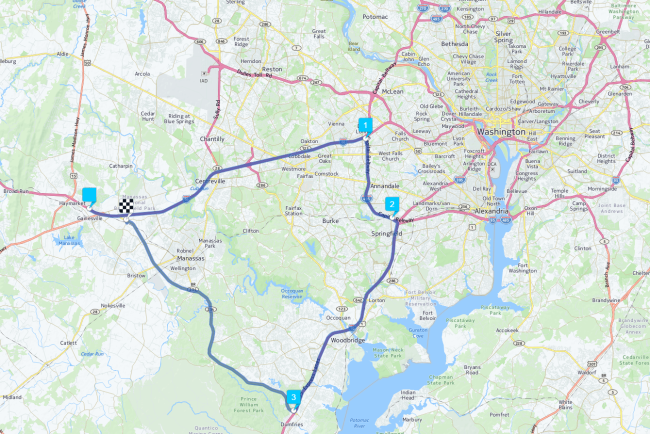
HERE
As car manufacturers work to develop fully and partially automated vehicles, they need to test their prototypes in real-world situations.
That’s why the Virginia Automated Corridors, or VAC, was developed—to provide a one stop shop that assists in evaluating and developing these vehicles. The VAC initiative was created after Virginia Governor Terry McAuliffe’s proclamation allowing automated vehicle testing on Virginia roadways, under the guidance of the Virginia Tech Transportation Institute’s Center for Automated Vehicle Systems, said Myra Blanco, the center’s director and lead on the VAC initiative.
The VAC is made up of 70 miles of urban interstates and rural arterials in Northern Virginia, and includes Interstates 66, 495, and 95, as well as state routes 29 and 50—some of the most congested roadways in the United States. The VAC also includes two test-tracks, one at the Virginia Smart Road, located on-site at VTTI, and the other at the Virginia International Raceway. Testing can also take place throughout the town of Blacksburg, where the center is located.
“In other states such as California and Nevada, you have to go through a process to test these vehicles on the roads,” Blanco said, noting there is no bond requirement in Virginia for this type of research. “We’ve been tracking that, and because we’ve been doing this type of research for a few decades, it made sense for us to create a testing process that was appealing to car manufacturers and suppliers. We created a stakeholder group and worked with the Governor’s office as well as the DMV in Virginia and the Department of Transportation.”
Once prototypes complete testing at the center, they can be taken into different real world situations throughout the VAC, whether it’s a fully automated vehicle picking people up downtown to take them to dinner and a movie or researchers testing automated accelerating and decelerating capabilities on a busy highway.
“If manufacturers or suppliers need to use test tracks or open roadways, we’re able to facilitate that,” Blanco said. “We actually already started doing some testing on the test track. We finished one last year for the U.S. Department of Transportation. We tested one prototype provided by GM and another one from Google.”
The VAC offers a variety of resources and features to facilitate this testing, including high-definition mapping capabilities, intelligent routing and location cloud technology supported by HERE, a Nokia company that has worked on automated vehicle projects in the past. The VAC also provides sophisticated, unobtrusive data acquisition systems that use multiple cameras and sensors, ubiquitous 1 cm accurate localization through a multichannel high-precision global navigation satellite system with real-time kinematic connections, an internal navigation system providing dead-reckoning and an update rate up to 100 Hz.
Dedicated high-occupancy toll lanes, in conjunction with Transurban, are also part of the VAC. Pavement markings on the roadways, implemented in conjunction with the Virginia Department of Transportation, are designed to help maintain standards for completeness of markings and retro-reflectivity properties.
These features not only enable manufacturers and suppliers to test in a variety of environments with all the technology they need, the VAC also makes it quick and easy for them to complete the process.
“You need to develop a way to independently evaluate these systems. It’s very easy to design something and say ‘I think it’s good.’ It’s a lot more powerful when you’re able to have an independent evaluation,” Blanco said. “This is something we’ve been doing with our partners for a very long time. Through VAC we’ll take care of all the logistics behind testing these vehicles on real roads and we’ll provide an individual evaluation on the system’s performance. We also have a group of engineers who can assist in the development process.”
Blanco has worked with VTTI since 1998, and over the years has seen many advancements in automated vehicle technology. While Blanco doesn’t think automated cars will be taking over the roads anytime soon, her center is doing its part to get them there. Blanco and her team want to put the pieces together that will get autonomous vehicles integrated into the roadways quickly and safely, from figuring out how to best integrate automated vehicles with legacy, or regular, vehicles to finding a way to get the different systems talking to each other and working together.
“We are working very hard in creating different stepping stones to get all the way to a fully automated vehicle,” Blanco said. “We’re going to get there but it isn’t going to be by next year.”
The Virginia Tech Transportation Institute’s Center for Automated Vehicle Systems recently opened up one of its test tracks to the public. They held a demonstration to show reporters various automated and connected vehicle capabilities, and how they test them at the center.

